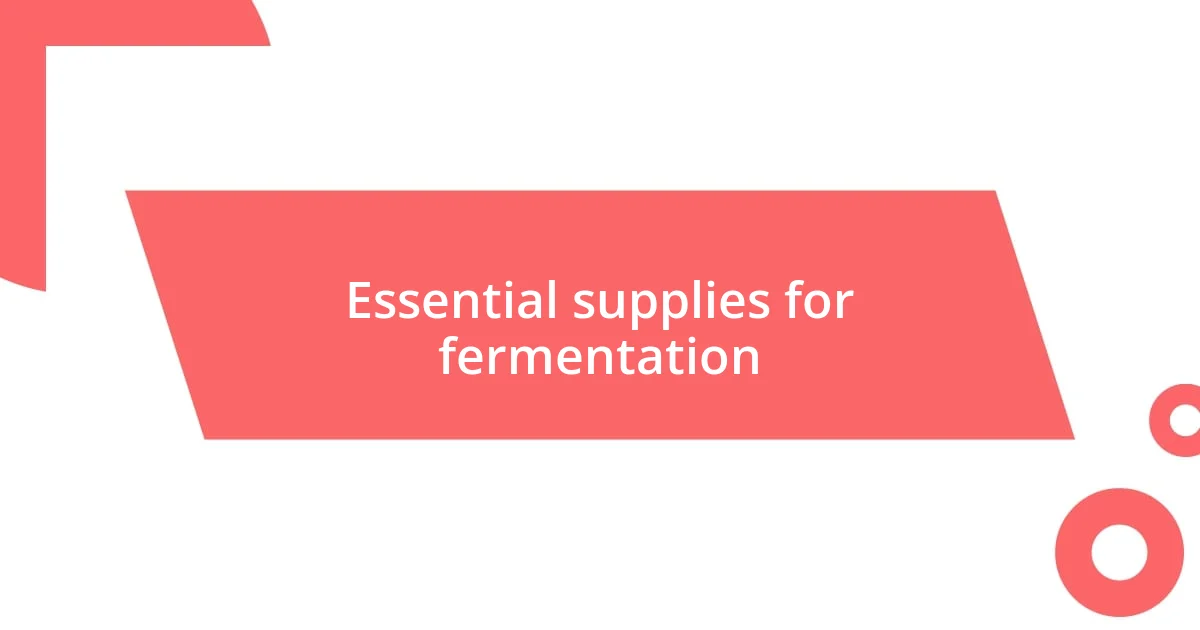Key takeaways:
- Home fermentation connects us to culinary traditions, offering health benefits through probiotic-rich foods while allowing for creativity and personal satisfaction.
- Essential supplies like glass jars, airlock kits, kitchen scales, and thermometers improve the fermentation process, ensuring accuracy and optimal conditions for beneficial bacteria.
- Common fermentation issues can be managed by understanding factors like exposure to air, salt balance, and fermentation signs like bubbling, enhancing the learning experience of home fermenting.

Introduction to home fermentation
Home fermentation is a fascinating journey that connects us with centuries of culinary tradition. I remember the first time I attempted to ferment vegetables; the excitement bubbled up just like the brine in my jar. What is it about the process that feels almost magical, transforming simple ingredients into something vibrant and full of life?
As I delved deeper into fermentation, I began to appreciate the science behind it—the way microorganisms work to preserve and enhance flavors. It’s an act of patience and creativity, don’t you think? Learning to trust the process, watching my creations evolve over time, turned every batch into a triumph or a lesson.
I often find myself pondering the health benefits, too. The tangy goodness of a homemade kimchi or kraut is not just delicious; it’s packed with probiotics that support our gut health. Have you ever thought how rewarding it feels to nourish your body with food you crafted yourself, experiencing both the risks and the delicious rewards along the way?

Benefits of fermenting at home
Fermenting at home has brought a multitude of advantages into my kitchen. For starters, there’s an incredible sense of accomplishment that comes from crafting something so beneficial. I remember the first time I bottled my homemade kombucha; it felt like uncorking a little celebration! Not only was it delicious, but I also knew I was sipping on a drink brimming with beneficial bacteria that support digestion. There’s something empowering about creating your own probiotic-rich foods, knowing exactly what goes into them.
The benefits extend beyond simply flavor and gut health. Homemade fermentation allows for greater control over ingredients and flavors. Here are a few more perks I’ve noticed:
- Enhanced nutritional value: Fermentation can increase vitamin levels and make nutrients more accessible.
- Cost-effective: Creating delicious fermented foods at home can be much cheaper than store-bought options.
- Reduction of food waste: Fermenting allows you to use surplus produce, transforming them into delightful preserves.
- Creative freedom: Experimenting with different ingredients and flavors means every batch can be unique.
- Connection to tradition: Fermentation links us to centuries of culinary heritage, deepening our appreciation of food.
I find it fascinating how this age-old practice can still resonate in modern kitchens, offering both nourishment and joy.

Essential supplies for fermentation
When I first ventured into fermentation, I quickly realized that having the right supplies was crucial. A good glass jar became my best friend. I remember the satisfaction I felt when I found a large, wide-mouth mason jar, perfect for my sauerkraut experiments. The transparent glass allows for easy monitoring of the bubbling process, which is always a delightful sight! Another essential item is an airlock fermentation kit; it might seem a little technical, but trust me, it makes a big difference in preventing unwanted bacteria.
I found that a kitchen scale really comes in handy, especially for weighing ingredients accurately to achieve that ideal salt concentration for brining. Initially, I was skeptical about measuring everything precisely, but I learned that this step can dramatically affect the flavor and texture of what you’re creating. There’s no guesswork involved when you have the right tools, which gives you the confidence to explore more complex recipes.
Don’t overlook the humble thermometer either. It was a game-changer for me while brewing kombucha. Keeping the brew at the right temperature can be critical for the fermentation process, and I often found myself hovering over it like a protective parent. It’s all about creating the best environment for beneficial bacteria to thrive, don’t you think?
| Essential Supplies | Description |
|---|---|
| Glass Jar | Ideal for fermenting vegetables; allows monitoring of fermentation activity. |
| Airlock Kit | Protects ferments from air, ensuring a healthy fermentation process. |
| Kitchen Scale | Ensures accurate measurements of ingredients for ideal brining. |
| Thermometer | Helps maintain the correct temperature for optimal fermentation. |

Choosing the right ingredients
Choosing the right ingredients for fermentation is crucial, and I’ve learned this the hard way! I remember my first attempt at fermenting carrots. I grabbed a bunch of the prettiest ones I could find, only to realize later that they lacked the crispness needed for a good crunch. Freshness really does matter; ingredients with a vibrant color not only enhance flavor but also contribute to the overall success of the fermentation process. Have you ever noticed how a fresh vegetable can brighten up your day?
Salt is another key player in the world of fermentation, and I quickly discovered that not all salts are created equal. Initially, I used table salt without giving it a second thought. It wasn’t until I tried sea salt that I appreciated the difference in flavor and texture. The mineral content in sea salt seemed to coax out the natural flavors of the vegetables, creating a delightful harmony. Isn’t it fascinating how something so simple can have such a profound impact?
Perhaps my favorite ingredient to experiment with has been spices. The first time I added dill to my pickles, I was taken aback by the explosion of flavor it brought to the jar. It’s incredible how a sprinkle of this or a dash of that can transform a straightforward fermentation project into a culinary adventure. What unique flavors could you explore if you let your creativity run wild with spices?

Step-by-step fermentation process
The fermentation process is both an art and a science. I start by preparing my ingredients, making sure they’re washed and cut to size. For my last batch of kimchi, I channeled my inner chef and meticulously sliced up napa cabbage, the vibrant green leaves contrasting beautifully with the fiery red chili flakes that would soon envelop them. Have you ever felt that thrill of anticipation while crafting something from scratch?
Next, it’s all about salt and water. I combine the right amount of salt with filtered water, creating a brine that ensures my vegetables will retain that delightful crunch. At first, I was a bit haphazard with my ratios, but after a few not-so-pleasant batches, I learned the importance of precision. Now, each sprinkle feels deliberate and adds character to what I’m making, resulting in that satisfying umami flavor that dances on my palate.
Lastly, I pack everything tightly into my fermentation jar, making sure no air bubbles are trapped. I vividly recall the first time I watched my jar bubble with life. It felt like I was nurturing something small and fragile. I often think, how rewarding is it to witness this transformation over the coming days? I can’t help but peek at them, marveling at how time and care can turn simple ingredients into something extraordinary.

Troubleshooting common fermentation issues
When fermentation goes awry, it’s often a matter of a few key factors. I remember a batch of sauerkraut that turned an unappealing shade of brown. It was disheartening to watch my beautifully shredded cabbage lose its vibrant color, but I discovered that too much exposure to air can wreak havoc. Have you ever opened up a jar only to be greeted by an off-putting smell? I learned the importance of keeping my ferments submerged beneath the brine to avoid that dreaded oxidation.
Another common issue is bubbling or foaming, which can be alarming at first. During my early fermentation days, I was startled by the vigorous fizz in my kombucha. Instead of being a cause for concern, I learned this is often a sign of happy yeast and bacteria doing their thing! So when this happens, I remind myself to embrace the chaos, knowing that it’s a part of the beautiful process of fermentation. Have you experienced that little moment of panic when things don’t go according to plan?
Sometimes, a fermentation can tempt you with hope but yield less-than-pleasant flavors. One time, my pickles tasted overly salty, almost punishingly so. I realized I hadn’t balanced the salt concentration properly. Now I keep a tasting spoon handy, checking the brine to ensure it’s just right—salty, but not overwhelming. It prompts me to wonder, how many flavor profiles can we unlock just by paying close attention to the balance of ingredients?















